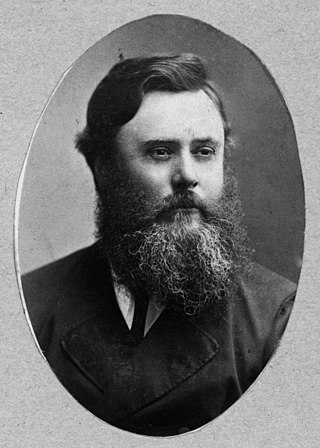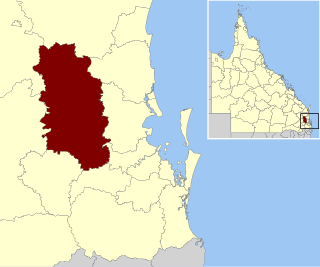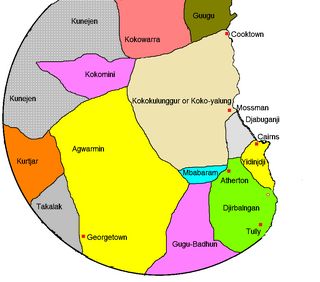
Brisbane is the capital of the state of Queensland and the third-most populous city in Australia and Oceania, with a population of approximately 2.6 million. Brisbane lies at the centre of South East Queensland, which includes several other regional centres and cities. The central business district is situated within a peninsula of the Brisbane River about 15 km (9 mi) from its mouth at Moreton Bay. Brisbane is located in the hilly floodplain of the Brisbane River Valley between Moreton Bay and the Taylor and D'Aguilar mountain ranges. It sprawls across several local government areas, most centrally the City of Brisbane. The demonym of Brisbane is Brisbanite.
Guugu Yimithirr, also rendered Guugu Yimidhirr, Guguyimidjir, and many other spellings, is an Australian Aboriginal language, the traditional language of the Guugu Yimithirr people of Far North Queensland. It belongs to the Pama-Nyungan language family. Most of the speakers today live at the community of Hope Vale, about 46 kilometres (29 mi) from Cooktown. However, as of June 2020 only about half of the Guugu Yimithirr nation speak the language. As such, efforts are being made to teach it to children. Guugu Yimithirr is the source language of the word kangaroo.
Djabugay is an endangered Australian Aboriginal language spoken by the Djabugay people with 46 native speakers at the 2016 census. The Djabugay language region includes Far North Queensland, particularly around the Kuranda Range and Barron River catchment, and the landscape within the local government boundaries of the Cairns Regional Council.

Thomas Petrie was an Australian explorer, gold prospector, logger, and grazier. He was a Queensland pioneer.

Brisbane Airport is a coastal suburb in the City of Brisbane, Queensland, Australia. In the 2021 census, Brisbane Airport had a population of 22 people.

The Somerset Region is a local government area located in the West Moreton region of South East Queensland, Australia, about 100 kilometres (62 mi) northwest of Brisbane and centred on the town of Esk. It was created in 2008 from a merger of the Shire of Esk and the Shire of Kilcoy. It is commonly known as the Brisbane Valley, due to the Brisbane River which courses through the region, although significant parts of the region lie outside the hydrological Brisbane Valley itself.
The Turrbal are an Aboriginal Australian people from the region of Brisbane, Queensland. The name primarily refers to the dialect they speak. The traditional homelands of the Turrbal stretch from the North Pine River, south to the Logan River, and inland as far as Moggill, a range which includes the city of Brisbane. Mianjin is also the Turrbal word for the central Brisbane area. There is debate over whether the Turrbal should be considered a subgroup of the Jagera people.

The Jagera people, also written Yagarr, Yaggera, Yuggera, and other variants, are the Australian First Nations people who speak the Yuggera language. The Yuggera language which encompasses a number of dialects was spoken by the traditional owners of the territories from Moreton Bay to the base of the Toowoomba ranges including the city of Brisbane. There is debate over whether the Turrbal people of the Brisbane area should be considered a subgroup of the Jagera or a separate people.
The Nyawaygi language, also spelt Nyawaygi, Nywaigi, Geugagi, Njawigi, Nyawigi or Nawagi, is an extinct Australian Aboriginal language that was spoken by the Nyawaygi people in North Queensland, on the east coast of Australia. The Nyawaygi language region includes the landscape within the Hinchinbrook Regional Council, Halifax Bay, and Rollingstone.
Jandai is an Australian Aboriginal language of the Quandamooka people who live around the Moreton Bay region of Queensland. Other names and spellings are Coobenpil; Djandai; Djendewal; Dsandai; Goenpul; Janday; Jendairwal; Jundai; Koenpel; Noogoon; Tchandi. Traditionally spoken by members of the Goenpul people, it has close affinities with Nunukul language and Gowar language. Today now only few members still speak it.

Durubalic is a small family of Australian Aboriginal languages of Queensland.

Wamin, also known as Agwamin or Ewamian, is an Australian Aboriginal language of North Queensland spoken by the Ewamian people. Wamin was traditionally spoken in the Etheridge region, in the areas around Einasliegh, Georgetown, and Mount Surprise.
Andjingith is an extinct Australian Aboriginal language once spoken in Cape York in Queensland. The traditional language area of Andjingith includes the Aurukun Community Council and the Cook Shire.
Mithaka is an extinct Australian Aboriginal language in the Barcoo Shire of Western Queensland spoken by the Mitaka people.
Pirriya is an extinct and unclassified Australian Aboriginal language. It was spoken by the Bidia people of the western and central western Queensland, including Barcoo Shire, Whitula Creek, Cooper Creek, and Jundah.

Toorbul is a coastal town and a locality in the City of Moreton Bay, Queensland, Australia. In the 2016 census, Toorbul had a population of 930 people.

The Quandamooka people are Aboriginal Australians who live around Moreton Bay in Southeastern Queensland. They are composed of three distinct tribes, the Nunukul, the Goenpul and the Ngugi, and they live primarily on Moreton and North Stradbroke Islands, that form the eastern side of the bay. Many were pushed out of their lands when the English colonial government established a penal colony near there in 1824. Each group has its own language. A number of local food sources are utilised by the tribes.
Lockyer is a rural locality in the Lockyer Valley Region, Queensland, Australia. In the 2016 census, Lockyer had a population of 95 people.
The Ngugi are an Aboriginal Australian people, one of three Quandamooka peoples, and the traditional inhabitants of Moreton Island.
The Nunukul, also spelt Noonuccal and known also as Moondjan are an Aboriginal Australian people, one of three Quandamooka peoples, who traditionally lived on Minjerribah, in Moreton Bay Area and in mainland Brisbane regions.








